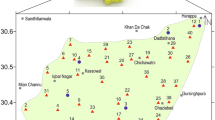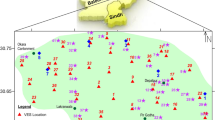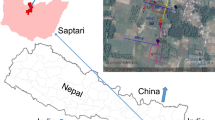Abstract
The geophysical method of investigation allied with borehole lithological logs was used integrally to explore promising zones of quality groundwater within district Pakpattan of Punjab province. Vertical electrical sounding technique of electrical resistivity survey (ERS) using Schlumberger electrode configuration was carried out to investigate subsurface hydrogeophysical conditions. In this alluvial Plain, ERS is the best tool for groundwater exploration. To achieve the target, thirty-one (31) vertical electrical soundings were conducted in the study area. A total of three (3) to five (5) geo-electric layers are identified through the software-based modeling along with the processed and interpreted resistivity data. The interpreted results decipher that the subsurface alluvial succession is primarily composed of clay, silt, sand, gravel, and some kankar inclusions. In terms of resistivity range, the study area is classified as very high (> 230 Ω-m), high (230–100 Ω-m), medium (< 100–40 Ω-m), low (< 40–20 Ω-m), and very low (< 20 Ω-m) resistivity zones. Below the water table, very low resistivity values are interpreted as unfit groundwater zones due to salinity and brackishness within thick segments mainly composed of sand and gravel. Low resistivity values are interpreted mainly as sand with admixture of fine silt and clay. The zones of low resistivity values are interpreted as groundwater with marginally fit condition. The zones of medium resistivity values are interpreted as the most promising zones of good-quality groundwater within sand-gravel strata with interbedded layers of fine silty clay/silt/clay. Moreover, below the water table, the zones of high and very high resistivities are also interpreted as the source of good quality groundwater. The 2D maps of the study area also lead to delineating fresh and saline groundwater zones. The saline zone appears at the depth of 50 m but the salinity increases rapidly with depth and goes on to replace the fresh groundwater as well. For irrigation and other industrial use, the optimizing site selection for water well installations is the key to a cost-effective approach and management of groundwater resources as well. To yield good-quality water, the locations of VES-1, 2, 6, 9–12, 14–17, and 21–31 are the most promising sites for installation of water wells at shallow depths. The water well can be installed within any suitable depth < 50 m. However, water turns to saline or marginally fit while depth increases. At VES-3, 4, 5, 7, 18, 19 and 20 the groundwater is expected to be marginally fit at even shallow depths. So, the water well installation at these sites would be optional and in only case of water shortage.













Similar content being viewed by others
References
ABEM Instrument AB (2010) Terrameter SAS4000 / SAS1000, instruction manual
Ahmad N, Chaudhry GR (1986) Irrigated agriculture of Pakistan. Shahzad Nazir Publishers, Lahore, pp 8–16
Ahmad N (1974) Waterlogging and salinity problems in Pakistan. Waterlogging and salinity cell - irrigation drainage and flood control research council, Lahore 1–22
Ahmad S (2007) Land and water resources of Pakistan-a critical assessment. Pakistan Dev Rev 911–937
Akhter G, Farid A, Ahmed Z (2012) Determining the depositional pattern by resistivity–seismic inversion for the aquifer system of Maira Area, Pakistan. Environ Monit Assess 184:161–170. https://doi.org/10.1007/s10661-011-1955-4
Ali SA, Sheikh MK, Mehmood SD, Rehman SU, Abrar AJ (1982) Hydrogeological data of Bari Doab Vol-I. Directorate General of Hydrology, WAPDA, Lahore
Alile OM, Amadasun CVO, Evbuomwan AI (2008) Application of vertical electrical sounding method to decipher the existing subsurface stratification and groundwater occurrence status in a location in Edo North of Nigeria. Intl J Phys Sci 3(10):245–249. https://doi.org/10.5897/IJPS.9000083
Ariyo SO, Banjo AA (2008) Application of electrical resistivity method for groundwater method for groundwater exploration in sedimentary terrain: a case study of Ilara – Remo, Southwest Nigeria. Continental J Earth Sci 3:53–58
Bender FK, Raza HA (1995) Geology of Pakistan. Salzweg-Passau Publisher, TutteDruckerie GmbH, pp 28–31
Borner FD, Schopper JR, Weller A (1996) Evaluation of transport and storage properties in the soil and groundwater zone from induced polarization measurements. Geophys Prospect 44:583–601. https://doi.org/10.1111/j.1365-2478.1996.tb00167.x
Burger HR, Sheehan AF, Jones CH (1992) Introduction to applied geophysics - exploring the shallow subsurface. WW North & Company Ltd 265–338
Dobrin MB, Savit CH (1988) Introduction to geophysical prospecting. McGraw-Hill Book Company 750–755
Farid A (2018) Geophysical characterization of Late quaternary basin deposits and hydrogeophysical modeling of Lakki Marwat and Domail Plains, Khyber Pakhtunkhwa, Pakistan. Ph.D. Thesis, University of the Punjab Lahore, Pakistan
Farid A, Khalid P, Jadoon KZ, Iqbal MA, Shafique M (2017) Applications of variogram modeling to electrical resistivity data for the occurrence and distribution of saline groundwater in Domail Plain, northwestern Himalayan fold and thrust belt, Pakistan. J Mt Sci 14(1):158–174. https://doi.org/10.1007/s12517-019-4372-6
Farid A, Khalid P, Jadoon KZ, Jouini MS (2014) The depositional setting of the late quaternary sedimentary fill in southern Bannu basin, northwest Himalayan fold and thrust belt Pakistan. Environ Monit Assess 186(8):6587–6604. https://doi.org/10.1007/s10661-014-3876-5
Hasan M, Shang Y, Akhter G, Jin W (2018) Delineation of contaminant aquifers using integrated geophysical methods in Northeast Punjab, Pakistan. Environ Monit Assess 192:12. https://doi.org/10.1007/s10661-019-7941-y
Hasan M, Shang Y, Akhter G, Jin W (2017a) Geophysical assessment of groundwater potential: a case study from Mian Channu Area, Pakistan. Groundwater 56:783–796. https://doi.org/10.1111/gwat.12617
Irfan M, Qadir A, Ali H, Jamil N, Ahmad SR (2019) Vulnerability of environmental resources in Indus Basin after the development of irrigation system. Irrigation-Addressing Past Claims and New Challenges. IntechOpen. https://doi.org/10.5772/intechopen.86722
Kazmi AH, Jan MQ (1997) Geology and tectonics of Pakistan. Graphic Publishers, Karachi, pp 41–53
Kearey P, Brooks M, Hill I (2002) An introduction to geophysical exploration. Blackwell Scientific Publications 183–196
Kelly WE (1977) Geoelectric sounding for estimating aquifer hydraulic conductivity. Ground Water 15:420–424
Khalid P, Sanaullah M, Sardar MJ, Iman S (2019) Estimating active storage of groundwater quality zones in alluvial deposits of Faisalabad area, Rechna Doab, Pakistan. Arab J Geosci 12:206. https://doi.org/10.1007/s12517-019-4372-6
Khalid P, Ullah S, Farid A (2018) Application of electrical resistivity inversion to delineate salt and freshwater interfaces in quaternary sediments of northwest Himalaya, Pakistan. Arab J Geosci 11:112. https://doi.org/10.1007/s12517-018-3471-0
Khan AD, Hagras MA, Iqbal N (2014) Quality evaluation in Thal Doab of Indus Basin of Pakistan. Int J Mod Eng Res 4(1):36–47
Kumar U (2019) Introduction to applied geophysics. Random Publications 35–37
Malik MA, Ashraf M, Ali B, Aslam AM (2019) Soil physical and hydraulic properties of the upper Indus basin of Pakistan. PCRWR, Islamabad 8–26 pp. https://doi.org/10.13140/RG.2.2.21104.00008
McArthur SAQ, Allen DM, Luzitano RD (2011) Resolving scales of aquifer heterogeneity using ground penetrating radar and borehole geophysical logging. Environ Earth Sci 63(3):581–593. https://doi.org/10.1007/s12665-010-0726-9
Mehmood Q, Mehmood W, Awais M, Rashid H, Rizwan M, Anjum L, Muneer MA (2020) Niaz Y (2020) Optimizing groundwater quality exploration for irrigation water wells using geophysical technique in semi-arid irrigated area of Pakistan. Groundwater Sust Devlop 11:100397. https://doi.org/10.1016/j.gsd.2020.100397
Milsom J (2003) Field Geophysics. John Wiley & Sons 97–110
Muhammad S, Khalid P (2017) Hydrogeophysical investigations for assessing the groundwater potential in part of the Peshawar basin, Pakistan. Environ Earth Sci 76: paper No. 494 https://doi.org/10.1007/s12665-017-6833-0
Omosuyi GO, Adeyemo A, Adegoke AO (2007) Investigation of groundwater prospect using electromagnetic and geoelectric sounding at Afunbiowo. Pac J Sci Technol 8:172–182
Parasnis DS (1986) Principles of applied geophysics. Chapman and Hall Publishers 115–120
Qureshi AS, Hussain A, Makin I (2002) Integrated database development for river basin management: an example from Rechna Doab. Working Paper 53. Lahore, Pakistan. International Water Management Institute. ISBN: 92–9090–500-X
Quraishi RH, Ashraf M (2019) Water Security issues of Agriculture in Pakistan. Pakistan Academy of Sciences, Islamabad 18–21 pp
Reynolds JM (2011) An introduction to applied and environmental geophysics. 2nd edition, John Wiley & Sons 415–491
Robinson ES, Coruh C (1988) Basic exploration geophysics. John Wiley & Sons 445–477
Saleem HS (1999) Determination of fluid transmissivity and electric transverse resistance for shallow aquifers and deep reservoirs from surface well log electric measurements. Hydrol Earth Syst Sci 3(3):421–427. https://doi.org/10.5194/hess-3-421-1999
Selvam S, Sivasubramanian P (2012) Groundwater potential zone identification using geoelectrical survey: a case study from Medak district, Andhra Pradesh, India. Int J Geomatics Geosci 3(1):55–62
Sharma VP (2004) Environmental and engineering geophysics. Cambridge University Press 209–240
Sikandar P, Bakhsh A, Arshad M, Rana T (2010) The use of vertical electrical sounding resistivity method for the location of low salinity groundwater for irrigation in Chaj and Rachna Doabs. Environ Earth Sci 60(5):1113–1129. https://doi.org/10.1007/s12665-009-0255-6
Singh SB, Stephen J, Srinivas Y, Singh UK, Singh KP (2002) An integrated geophysical approach for groundwater prospecting: a case study from Tamil Nadu. J Geol Soc India 59:147–158
Srinivasan K, Poongothai S, Chidambaram S (2013) Identification of groundwater potential zone by using GIS and electrical resistivity techniques in and around the Wellington reservoir, Cuddalore District, Tamil Nadu, India. Eur Sci J 9(17):312–331
Sultan SA, Mekhemer HM, Santos FAM, AbdAlla M (2009) Geophysical measurements for subsurface mapping and groundwater exploration at the central part of the Sinai Peninsula, Egypt. Arab J Sci Eng 34(1A):103–119
Telford WM, Geldart LP, Sheriff RE (1990) Applied geophysics. Cambridge University Press, London 524–539 pp. https://doi.org/10.1017/CBO9781139167932
Water and Power Development Authority (WAPDA) (1989) Annual reports 1988–89, Lahore 21–98 pp
Zhou Y, Li W (2011) A review of regional groundwater flow modeling. Geosci Front 2:205–214. https://doi.org/10.1016/j.gsf.2011.03.003
Author information
Authors and Affiliations
Corresponding author
Ethics declarations
Ethics approval and consent to participate
This article does not contain any studies with animals and human subjects. The authors confirm that all the research meets ethical guidelines and adheres to the legal requirements of the study region. Moreover, this manuscript has not been published previously in any form (partially or in full) and is not under consideration for publication elsewhere.
Consent for publication
The authors declare that this manuscript does not contain any individual person’s data and material in any form.
Conflict of interest
The authors declare no competing interests.
Additional information
Responsible Editor: Broder J. Merkel
Rights and permissions
About this article
Cite this article
Muhammad, S., Ehsan, M.I. & Khalid, P. Optimizing exploration of quality groundwater through geophysical investigations in district Pakpattan, Punjab, Pakistan. Arab J Geosci 15, 721 (2022). https://doi.org/10.1007/s12517-022-09990-8
Received:
Accepted:
Published:
DOI: https://doi.org/10.1007/s12517-022-09990-8




